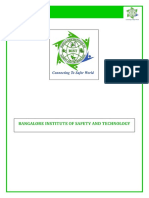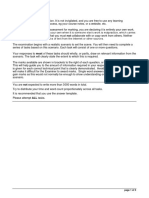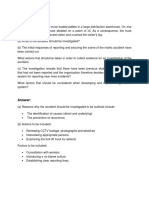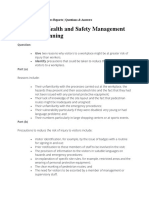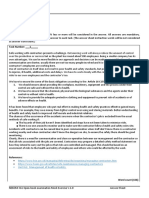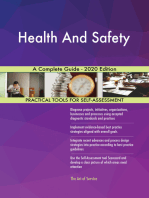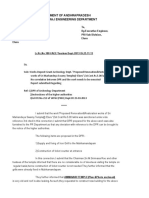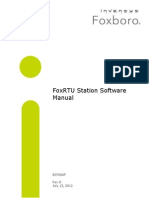NEBOSH Exam Hints & Tips
NEBOSH Exam Hints & Tips
Uploaded by
Sarath ChandranCopyright:
Available Formats
NEBOSH Exam Hints & Tips
NEBOSH Exam Hints & Tips
Uploaded by
Sarath ChandranCopyright
Available Formats
Share this document
Did you find this document useful?
Is this content inappropriate?
Copyright:
Available Formats
NEBOSH Exam Hints & Tips
NEBOSH Exam Hints & Tips
Uploaded by
Sarath ChandranCopyright:
Available Formats
NEBOSH National General Certificate
Exam Hints & Tips
Now you've committed yourself to taking the NEBOSH Certificate, you've probably wondered
what you've got yourself into! Hopefully the following hints & tips will help you to get the
maximum marks possible.
Tips for the Written Papers
First Things First!
Start by reading the exam paper all the way through. You should find at least one question
that you are confident about answering. The pages in your answer book are numbered
according to the question you are answering, so it doesn't matter in which order you do the
questions, as long as you put your answer on the corresponding page of the answer book. It's a
good idea to start with the question you're happiest about, as this gets your brain working and
gives you confidence. Work through a couple of 'easier' questions & then tackle some of the
harder ones. Just make sure you attempt them all!
Clock Watch!
You must keep your eye on the time. You are allowed 2 hours for each paper. There are 11
questions on each paper, and you are expected to answer every one. Question 1 is worth 20
marks, and you should allocate about 25 minutes for your answer. Questions 2-11 are worth 8
marks each, and therefore you have to answer 10 questions in 90 minutes. If you allow 8
minutes for each question, you will have a small cushion at the end to check over your paper, or
to finish any last bits.
Please remember: -
It is better to provide an answer to every question than to do 9 or 10 of them well!
Statistically, candidates score the most marks for the information they give at the beginning
of their answers. You will get very few extra marks for a long, rambling answer. It's also
worth remembering that for any question you fail to attempt, your score will be ZERO!
So, answer every question, even if you're not over-confident. If you have reached the time
limit (25 minutes for Q1 & 8 minutes for each of the others) MOVE ON! You do not want to
end up wasting time perfecting one answer if it means you run out of time to attempt all the
questions.
Answer the Question!
We all know the sorts of questions we would like to be on the paper - trouble is, they're not
always there! You need to:
Jane Riley 2007
www.asats.co.uk
• READ THE QUESTION
Get an idea of what the question is asking. This is especially important on Q1, which is
often a part question. It is very easy to start rushing in to the answer, only to find when
you get to part (ii) that you're writing similar things. NEBOSH do not ask you to give the
same information twice in one question, so if this is happening, you're going wrong.
• READ IT AGAIN, BEFORE YOU START WRITING!
This will give you an idea of the depth of answer required, denoted by the action verb
(e.g. outline, describe, state, list etc). It also focuses your mind on actually answering. It
is a good idea to highlight the important words in the question, either by underlining them
or by using a highlighter pen. Again, this clarifies what you are being asked and allows you
to think about what your answer should be. You can’t take your exam paper away with you,
but you can highlight things on it.
• Once you've started your answer, check the question to make sure you're answering
what you've been asked.
If I had £1 for every student who'd gone off at a tangent in their answer to a NEBOSH
question, I'd be a very rich lady!! You will do this at some point, but it's a good idea to
make sure it happens in the classroom rather than in the exam! Simply by checking that
you are answering the question, whilst you are doing it can save an awful lot of time &
heartache. If you check halfway through, it does give you time to salvage something if
you've gone wrong. (I’ve done it!).
Question Spotting!
NEBOSH are well aware that students practice answering past questions, and although they
do repeat questions, they may not be straight repeats. You may see part of a question that
has appeared before, with a different second part. Just be aware that you must read the
question thoroughly and keep checking that you’re answering the right question.
Specific Types of Question
Some types of question come up again & again. On the Management paper you are often asked
to "Outline the factors to consider when……..". This type of question requires you to think
about the situation you have been given, and take an overview. They do not usually ask you to
fix it! i.e. you do not have to outline a series of control measures. This is a very common
mistake in approaching this type of question.
E.g. If you were asked to outline the factors to consider before forklift trucks are to be
introduced to a new warehouse, you would outline factors such as
• The need for separating FLT movements from pedestrians;
• The need for the introduction of speed limits;
• Whether high visibility clothing would be required;
• The condition of the floors and terrain
• The type of FLT to be introduced e.g. the appropriate fuel supply
Jane Riley 2007 2
www.asats.co.uk
• The loads to be carried etc.
You should turn this list into an outline by adding the reason for each consideration you
mention e.g. The condition of the floors and terrain would be an important consideration, as
floors containing potholes or steep slopes can result in overturning of fork lift trucks.
It is tempting to try to fix the situation by giving answers such as: -
When FLTs are to be introduced into the workplace, it is essential that they do not come in to
contact with pedestrians. In order to prevent this, dedicated traffic routes should be
introduced, with speed limits. Any pedestrians who enter the area in which the FLTs are
moving should wear appropriate PPE, such as high-visibility vests. In a warehouse, you should
make sure that if the ventilation is poor, the FLTs are battery-powered. The floors should be
free from potholes, as this can cause overturning of the FLT……………
These are in fact control measures to reduce the risks from FLTs operating in a new
warehouse - but that's not actually what the question asked you for!! If you start doing this,
you will get carried away & start answering a different question from the one you’ve been
asked – don’t do it!
If you have trouble interpreting "Outline the factors to consider”, substitute “things” for
“factors” & it might make the question easier to understand.
Hazards paper questions are usually a bit more straightforward, requiring either hazard
identification or control measures or both.
Make sure that you understand the difference between hazard & risk. Some questions may
ask you to identify hazards & others will ask for risks. If you get these mixed up, you may not
get the marks. Remember that risks are outcomes.
Your answers
There are some basic rules to follow:-
• Answer the question you’ve been set!
• Don’t write a list if you’re asked for an outline (unless you’re running out of time) – you
will loose marks.
• If you include training, instruction or information as an answer, say what sort of
training, information or instruction is required.
• PPE is not sufficient as an answer, even in a list – give some examples of suitable PPE.
• Answer the question you’ve been set!
• If you’re asked for a list, single words are unlikely to score you marks. It’s not a
shopping list - you need enough details to make the examiner understand what your
point is.
• Use principles to keep you organised. E.g. if you’re asked for controls, work through
the Hierarchy of control giving appropriate examples; if you’re asked how you would
manage a situation – apply the principles of HSG65 etc.
• Answer the question you’ve been set!
Jane Riley 2007 3
www.asats.co.uk
Always remember, although Examiners are intelligent, they don’t know you – you have to
get your answer down on paper in a way that tells them exactly what you mean.
When you've finished!
You should have a few minutes spare to check through your answers. Yes, I know it's boring,
but you may think of something you couldn’t answer earlier, see part of a question you’ve
forgotten to answer or see a glaring error. It's easier to pick up the odd extra mark by filling
in gaps in questions which require you to list or identify, so if you've missed any out, now's the
time to check what you've written and see if you've missed anything obvious.
FAQs
What if I'm running out of time?
If you find yourself with only minutes to spare to the end of the exam, & you still have a
question to do, complete it as a list. This at least gives you the chance to get some marks,
rather than leaving it blank and scoring zero. The extra marks you pick up here could make the
difference between referral/ pass; pass/credit, or even credit/distinction! If you do have
some time spare on an outline, describe or explain question, add a reason or an example – it
may get you full marks.
How can I improve my chances of passing?
• Revise as you go - you cannot leave it until the last minute, as there is far too much
information to take in. Also you need to ensure that you understand what you've been
taught/have read. If you are having problems, you will be able to clarify them with your
tutor in plenty of time.
• Practice past questions - You can obtain past question papers and Examiners' Reports
from the NEBOSH website www.nebosh.org. You should aim to practise answering
questions and then check your answer against the Examiners' comments. There are often
repeated questions on exams, so having practised a good selection may help with any
repeated questions on your exam.
• Don't panic! - Panic will just make it harder to answer the questions. It can be tempting
when you read the exam paper to panic if you think you can't do some of the questions.
Just breathe deeply, read the question paper again & start with a question you are
reasonably happy with.
Tips for the Practical
The Inspection
Get organised! Think of the areas that you need to look at. Put those headings on individual
sheets at the start of the exam. There’s no restriction on the number of sheets you use.
Jane Riley 2007 4
www.asats.co.uk
Make sure you fill in each column of the observation sheet – don’t leave the risk level or the
action required columns blank, as it will reduce your marks.
Don’t mark everything as high risk which needs action immediately – your suggested corrective
action needs to be achievable as well as aimed at reducing the risks.
Aim to give a spread of actions to correct problems where possible. Single actions often don’t
prevent the problem from recurring, and may need considerable budget. Suggest some
intermediate steps to reduce risk progressively with sensible timescales. Ongoing monitoring
also signifies that some solutions need checking to maintain their effectiveness.
The Report to Management
This needs to be concise, convincing and it needs to address URGENT issues. Your time is
short, so the report also needs to be short.
Use headings and give it a structure. A summary will aid readability and will persuade (or not!)
the manager to read the full report.
Pick no more than 5 urgent issues and make sure that for each one, you say:-
What you found (in general terms)
Why it's a problem (what the possible outcomes are)
What legislation is being breached (e.g. contravenes the COSHH Regulations)
What needs to be done (include any statutory requirements e.g. Requirement of Fire
legislation that all premises have an emergency plan)
Who needs to do it (e.g. workshop manager)
Timescale (e.g. should be carried out within the next week). Don't forget to include longer-
term action where appropriate.
An indication of cost (low, medium, high)
Remember that in general you are asking management to part with money, so you need to
convince them that they should! State the likely benefits of implementing your suggested
actions e.g. reduces the risk of serious injury to students and the likelihood of enforcement
action and civil claims.
Remember to include both breeches of legislation and costs – these are commonly forgotten
and there are a total of 10 marks available for them.
GOOD LUCK!
Jane Riley 2007 5
www.asats.co.uk
You might also like
- Criminal Procedure ReviewerDocument51 pagesCriminal Procedure ReviewerJingJing Romero94% (161)
- Unit Ng1 and Ng2 Sample Resource PackDocument62 pagesUnit Ng1 and Ng2 Sample Resource PackRouf AhmadNo ratings yet
- Secrets of Passing the Nebosh Exams: Don’T Study Hard, Just Study SmartFrom EverandSecrets of Passing the Nebosh Exams: Don’T Study Hard, Just Study SmartRating: 4.5 out of 5 stars4.5/5 (6)
- Ig1 - E1Document44 pagesIg1 - E1ijaz ahmad100% (1)
- Nebosh Obe Learner Guide PDFDocument12 pagesNebosh Obe Learner Guide PDFAsmaael adnanNo ratings yet
- Questions and Answers Related To IGC Week 1 Elements 1 To 5Document13 pagesQuestions and Answers Related To IGC Week 1 Elements 1 To 5geologistlakhanNo ratings yet
- Nebosh Revision Guide IGC 1Document30 pagesNebosh Revision Guide IGC 1Abdelaali100% (6)
- Q.3 and 7Document2 pagesQ.3 and 7mirza6aqeel6ahmedNo ratings yet
- Apple and Its SuppliersDocument3 pagesApple and Its SuppliersVikas Upadhyay100% (1)
- Automation Project Management - Org Chart OmissionsDocument6 pagesAutomation Project Management - Org Chart OmissionsKALPUSHNo ratings yet
- 4th PepperDocument11 pages4th Peppersyed zadaNo ratings yet
- Microsoft PowerPoint - IG1 Element 4Document19 pagesMicrosoft PowerPoint - IG1 Element 4saadNo ratings yet
- Nebosh Igc Q/aDocument7 pagesNebosh Igc Q/amunawar100% (1)
- International General Certificate: About The CourseDocument5 pagesInternational General Certificate: About The CourseAustin Runaway DreamcrafterNo ratings yet
- Mock Exam Scenario 1 PDFDocument2 pagesMock Exam Scenario 1 PDFUsama AshiqNo ratings yet
- Pepper 6Document8 pagesPepper 6syed zada100% (1)
- Ig1-Obe-Qp - 5Document5 pagesIg1-Obe-Qp - 5Okay GoogleNo ratings yet
- Igc 1.5 PDFDocument7 pagesIgc 1.5 PDFclementNo ratings yet
- NGC1 Rev NotesDocument56 pagesNGC1 Rev NotesPrimelift Safety Resources LimitedNo ratings yet
- 6 August 2020 Answer Exam English - PDFDocument11 pages6 August 2020 Answer Exam English - PDFMohamed Salar100% (1)
- Igc 1 Notes PDFDocument103 pagesIgc 1 Notes PDFnadeem100% (1)
- Nebosh Certificate Course NotesDocument63 pagesNebosh Certificate Course NotesKevin Josh BonalesNo ratings yet
- Topic Focus Igc 2 - Green World GroupDocument15 pagesTopic Focus Igc 2 - Green World GrouppmnasimNo ratings yet
- Exam Questions 1Document11 pagesExam Questions 1mohammed a.malek100% (1)
- IGC-1 Related Important NotesDocument64 pagesIGC-1 Related Important NotesGurdhianSingh100% (2)
- NEBOSH New Check List Dec 2020Document3 pagesNEBOSH New Check List Dec 2020Allen Joe George100% (1)
- Scenario Based Q&As For PracticeDocument9 pagesScenario Based Q&As For PracticehamidsohailNo ratings yet
- Naveen Na ExamDocument9 pagesNaveen Na ExamT.S PraveenNo ratings yet
- NEBOSH OBE Question Paper December 2020: Home Know Us Career Guide Categories Jobs PaperDocument2 pagesNEBOSH OBE Question Paper December 2020: Home Know Us Career Guide Categories Jobs Paperfaceji0% (1)
- Element 4 Health and Safety Management Systems - PlanningDocument18 pagesElement 4 Health and Safety Management Systems - PlanningRafa'eel BickooNo ratings yet
- Aug 6th Solved Paper 2Document19 pagesAug 6th Solved Paper 2naanigaaduscribdNo ratings yet
- 2nd PeperDocument7 pages2nd Pepersyed zada100% (1)
- PP - IGC2 - Element 8 - Sample 2nd Edn v.1.0Document5 pagesPP - IGC2 - Element 8 - Sample 2nd Edn v.1.0Ahsan ChuhadryNo ratings yet
- Unit 1 IGC Questions and Answers 86Document85 pagesUnit 1 IGC Questions and Answers 86Dump Facility100% (1)
- Nebosh Summary IGC2-2Document11 pagesNebosh Summary IGC2-2Muhammad Shafaat Awan100% (16)
- Nebosh Q & A Igc 1Document14 pagesNebosh Q & A Igc 1manofatima931100% (1)
- Abdul Mateen Mock Test 2Document9 pagesAbdul Mateen Mock Test 2Abdul MateenNo ratings yet
- NEBOSH IGC NotesDocument9 pagesNEBOSH IGC NotesHaseeb100% (1)
- NGC 1.1 Revision Answers v2.2Document11 pagesNGC 1.1 Revision Answers v2.2Amon Ra0% (1)
- Igc1 Mock 1. Solved PaperDocument6 pagesIgc1 Mock 1. Solved Paperdroffilcz27No ratings yet
- Learner Guide by NEBOSHDocument13 pagesLearner Guide by NEBOSHNaizil KareemNo ratings yet
- IG1 - 0039 ENG OBE Answer Sheet V1 PDFDocument8 pagesIG1 - 0039 ENG OBE Answer Sheet V1 PDFayaanjawed6100% (1)
- IGC 1 QuesDocument5 pagesIGC 1 QuesanoopNo ratings yet
- Nebosh: Element 4: Health and Safety Management Systems - CheckDocument29 pagesNebosh: Element 4: Health and Safety Management Systems - CheckmohammadNo ratings yet
- Nebosh Summary IGC2Document10 pagesNebosh Summary IGC2w hiteNo ratings yet
- IGC1 Sample AnswersDocument7 pagesIGC1 Sample Answerskukuji67% (3)
- Nebosh Igc 1Document21 pagesNebosh Igc 1Pradeep PooNoor100% (1)
- IG1 SummaryDocument48 pagesIG1 Summarykhalifa983100% (1)
- IGC2 Examiner's ReportsDocument18 pagesIGC2 Examiner's Reportssaqibsaeed18100% (6)
- Rashid Assignment 05Document8 pagesRashid Assignment 05Kaif koilkarNo ratings yet
- Example Question Paper and Examiners' Feedback On Expected Answers (NGC1)Document12 pagesExample Question Paper and Examiners' Feedback On Expected Answers (NGC1)hamidsohailNo ratings yet
- Ig1 - Igc1 Eng December2021Document6 pagesIg1 - Igc1 Eng December2021MILTON OKELLO100% (1)
- IGC Revision QuestionsDocument46 pagesIGC Revision QuestionshogoshNo ratings yet
- Creating A Culture Of Safety A Complete Guide - 2020 EditionFrom EverandCreating A Culture Of Safety A Complete Guide - 2020 EditionNo ratings yet
- Stay Safe This Summer: Health and Safety for Young WorkersFrom EverandStay Safe This Summer: Health and Safety for Young WorkersNo ratings yet
- Occupational health and safety A Complete Guide - 2019 EditionFrom EverandOccupational health and safety A Complete Guide - 2019 EditionNo ratings yet
- Baywood Dermatology: Job Search AssignmentDocument4 pagesBaywood Dermatology: Job Search Assignmentapi-455876561No ratings yet
- Retail Client - Risks and Risk Ratings TemplateDocument31 pagesRetail Client - Risks and Risk Ratings TemplatessglcnNo ratings yet
- Anthony Paz Torres' Feb. 11 Arrest in Rockwall CountyDocument5 pagesAnthony Paz Torres' Feb. 11 Arrest in Rockwall CountyNaheedNo ratings yet
- 1 FM CID 001 Annual Instructional Supervisory and Monitoring Plan SEPTEMBERDocument2 pages1 FM CID 001 Annual Instructional Supervisory and Monitoring Plan SEPTEMBERBENJ AMIN100% (2)
- Final Module (ENTREP)Document13 pagesFinal Module (ENTREP)cyrelle rose jumentoNo ratings yet
- Brooklyn Center City Attorney StatementDocument2 pagesBrooklyn Center City Attorney StatementMatt McKinneyNo ratings yet
- Gorbachev and ReformsDocument24 pagesGorbachev and ReformsMofeOmatsoneNo ratings yet
- Procurement Pps D Short Form TemplateDocument4 pagesProcurement Pps D Short Form TemplateScg RovayoNo ratings yet
- Corporate Brochure Template A4Document2 pagesCorporate Brochure Template A4Mahmoud Odeh AllanNo ratings yet
- Distribution Center Management: A Best Practices Overview: The Abcs of DcsDocument48 pagesDistribution Center Management: A Best Practices Overview: The Abcs of DcsBrayan Quispe CorcinoNo ratings yet
- English Forward Planning DocumentDocument3 pagesEnglish Forward Planning DocumentHollyNo ratings yet
- Response 1 InstructionsDocument2 pagesResponse 1 InstructionsKellyPatrick SpencerNo ratings yet
- Different Ways of Escaping The StressDocument1 pageDifferent Ways of Escaping The StressThakor JoshiNo ratings yet
- Guide To The Clinical Research Associate (CRA) Role: Chapter IiDocument6 pagesGuide To The Clinical Research Associate (CRA) Role: Chapter IisiriNo ratings yet
- Module Page 28 Module Page 24Document4 pagesModule Page 28 Module Page 24ARLENE MARASIGANNo ratings yet
- Speaking Topics For School ContestDocument2 pagesSpeaking Topics For School ContestAndrii VerbovyiNo ratings yet
- Revision Mega Goal 1.1Document17 pagesRevision Mega Goal 1.1nesrin godaNo ratings yet
- IIM Lucknow: Indian Institute of Management LucknowDocument5 pagesIIM Lucknow: Indian Institute of Management LucknowGurpreet SinghNo ratings yet
- Chap 11 Risk ManagementDocument39 pagesChap 11 Risk ManagementIwan Saputra100% (4)
- Harsha M. de Silva: Consultant EconomistDocument6 pagesHarsha M. de Silva: Consultant EconomistlirneasiaNo ratings yet
- Info On Scientology's Private Investigators Up To 2007Document17 pagesInfo On Scientology's Private Investigators Up To 2007Mary McConnell100% (1)
- Reference Manual: Programmable TerminalsDocument482 pagesReference Manual: Programmable Terminalsvuitinhnhd9817No ratings yet
- CHRDR Application FormDocument2 pagesCHRDR Application FormNifee NipsNo ratings yet
- Government of Andhrapradesh Panchayat Raj Engineering DepartmentDocument2 pagesGovernment of Andhrapradesh Panchayat Raj Engineering DepartmentD.V.Srinivasa RaoNo ratings yet
- E Prospectus 2020 21Document200 pagesE Prospectus 2020 21Azharmp504 Azharmp504No ratings yet
- FoxRTU SoftwareManualDocument239 pagesFoxRTU SoftwareManualhbahriioNo ratings yet
- The 12 Principles ofDocument20 pagesThe 12 Principles ofAnna Milen Acuña CapuliNo ratings yet



